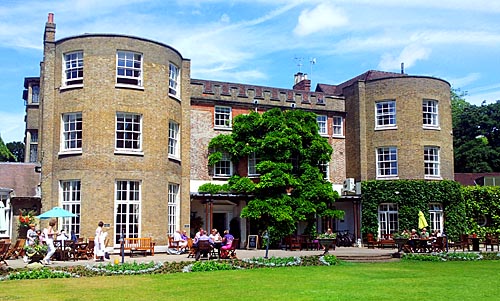 |
 |
|||
|
|
 Lullebrook
Manor Lullebrook
ManorCookham, Berkshire Lullebrook Manor is the twin to Lillibrook Manor in the adjoining parish of Bray. The words have changed spellings over the years, but both are named after their nearby 'singing streams'. In the 13th and 14th centuries, Lullebrook was owned by the De Lullebrook family who took their name from their estate. They must have had a substantial manor house on the site, since Joan, widow of Robert De Lullebrook, obtained permission to add an oratory to it in 1341. Sir William Trusell later obtained the manor and granted it to his ecclesiastical college foundation at Shottesbrooke and the canons remained in possession until the Dissolution of the Monasteries. The Weldons of Cannon Court then purchased the place, but quickly passed it on, in 1590, to Thomas Ferrers (alias Turner), a member of a lesser branch of the great De Ferrers family of Tutbury Castle in Staffordshire. He, no doubt, would have built himself a fine Tudor mansion on the site. Thomas' son, John, is said to have lived to the ripe old age of one hundred. His great-grandson, John Ferrers II, was a bit of a hot-head and got himself involved in a duel, something which he neglected to tell his wife. When he turned up at Lullebrook with a serious injury, this pregnant lady went into premature labour at the shock. A difficult birth led to their son, Benjamin, being born deaf and dumb. He became a talented artist when he grew up and used his sketches to communicate with the world around him. His brother, Thomas De Ferrers, was a well-known Brigadier-General who fought under the Duke of Marlborough during the War of the Spanish Succession and became an MP in Pembrokeshire where he held an estate inherited from his wife's family. The Ferrers sold Lullebrook to Thomas Lee at the time of the Restoration, although they seem to have remained as tenants for a few years. John Lee was lord of the manor in 1720 and he was later succeeded by his daughter, Elizabeth, and her husband, Rev. Dr. Richard Wells (1727-1804). It is not known how often they lived there, as Richard and his son were both Rectors of Ellesborough in Buckinghamshire, but today's house may have been built for them as a wedding present. They later added the prominent bow-window wings around the time of Richard's retirement in 1802. He called the house 'Cookham Elms'. After the death of Rev. Dr. Joseph Wells (1756-1818) in 1818, the manor was sold to William Wickham (1761-1840), who had been the British spymaster general during the French Revolution, but he soon passed it on to the Coney family and then William Hieatt. In 1828, James Walter Burrows purchased the house. James Burrows was a London leather-merchant who was forced to retire to the country due to ill-health. Seeing the local cobblers struggling to make a descent living, he encouraged them to make high quality ready made boots and shoes, supplying them with materials and a market. Around Lullebrook, Burrows established a thriving industry, employing 1,500 people, although most of the production was done by outworkers. They would all arrive in the village on Fridays with their finished boots carried over their shoulders. Mr. Burrows' sons kept the industry going into the 1880s but increasingly cheap competition from factories in Northampton and Leicester eventually led to its collapse in Cookham. In the early 20th century, the Burrows family rented the manor out to Francis Cecil Ricardo from the Friary in Old Windsor, a colonel in the Grenadier Guards who was brother to the Duchess of Richmond. He was a larger-than-life character who did much for the village community. He gave a vast rood screen to the local church, reformed the fire brigade, began a shooting club, had a cricket pitch laid out by the Oval groundsman and led the singing in regatta concerts. He was the first person in the village to own a motor car: a bright yellow Rolls Royce with a large horn on the side that went 'poop, poop'. It is generally supposed that he was the inspiration for local man Kenneth Grahame's Mr. Toad in 'Wind in the Willows'. The estate was purchased by the John Lewis Partnership in 1927 and is currently run as a holiday centre for its staff. Lullebrook
Manor is a Private Members Club owned by the John Lewis Partnership.
|
|||
| © Nash Ford Publishing 2013. All Rights Reserved. | ||||


